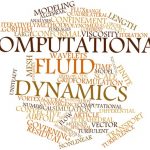
Computational Fluid Dynamics (CFD) is a branch of fluid mechanics that solves mathematical equations using numerical methods and algorithms to solve and analyze fluid flow problems, heat transfer, mass transfer, various chemical reactions and any related phenomena.
It has become an essential tool in engineering and scientific research for simulating and predicting the behavior of fluids in various applications, from aerospace and automotive engineering to environmental modeling and biomedical research. In this article, we will explore the principles, methods, applications, and challenges of Computational Fluid Dynamics in detail.
Principles of Computational Fluid Dynamics
At its core, Computational Fluid Dynamics relies on the fundamental equations of fluid mechanics, such as the Navier-Stokes equations, which describe the motion of fluids in terms of velocity, pressure, density, and viscosity. These equations, along with conservation laws for mass, momentum, and energy, form the basis for simulating fluid flow behavior using numerical methods.
The process of solving fluid flow problems using CFD typically involves several steps:-
- Problem Definition: This step involves defining the geometry of the fluid domain, boundary conditions, initial conditions, and physical properties of the fluid. The geometry may include solid surfaces, fluid inlets, outlets, and any other features relevant to the flow problem.
- Discretization: The continuous equations governing fluid flow are discretized into a set of algebraic equations using numerical methods such as finite difference, finite volume, or finite element methods. This process involves dividing the fluid domain into a grid or mesh and approximating the equations at discrete points or elements within the mesh.
- Solution: The discretized equations are solved iteratively using numerical techniques to obtain approximate solutions for velocity, pressure, and other flow variables at each point or element in the mesh. Common solution algorithms include iterative solvers, linear solvers, and multigrid methods.
- Post-Processing: Once the solution is obtained, post-processing techniques are used to analyze and visualize the results. This may involve generating flow visualizations, computing derived quantities such as forces and heat transfer rates, and comparing simulated results with experimental data or analytical solutions.
Methods and Techniques in Computational Fluid Dynamics
Computational Fluid Dynamics employs a variety of numerical methods and techniques to solve fluid flow problems efficiently and accurately. These methods are used in dicretization. Some of the key methods and techniques include:
- Finite Difference Method (FDM): FDM discretizes the partial differential equations governing fluid flow using finite differences, approximating derivatives with finite increments. It is commonly used for simple geometries and steady-state problems. It is only used in a few specialised codes that can resolve complex geometries with high accuracy and efficiency by using embedded boundaries or overlapping grids with the solution interpolated across each grid.
- Finite Volume Method (FVM): FVM discretizes the fluid domain into control volumes, where the equations are integrated over each volume and solved for the average values of flow variables. FVM is well-suited for complex geometries and unstructured grids. It has low memory usage and rapid solution speed. It is good for handling large problems where there are high Reynolds number turbulent flows and source term dominated flows such as combustion. In this method the governing partial differential equations are recast in a conservative form and then solved over a discrete control volumes which guarantees the conservation of fluxes through a particular control volume.
- Finite Element Method (FEM): FEM discretizes the fluid domain into finite elements, where the equations are approximated using piecewise polynomial basis functions. It is used in the structural analysis of solids as well as fluids. FEM is particularly useful for problems involving structural coupling or complex boundary conditions. It is more stable than the finite volume approach. It requires more memory and is slower in computing spped than the FVM method.
- Boundary Element Method (BEM): BEM discretizes only the boundary of the fluid domain, representing the interior solution using fundamental solutions of the governing equations. BEM is advantageous for problems with large open domains or exterior flows.
- Mesh Generation: Mesh generation is a critical step in CFD that involves creating a grid or mesh to discretize the fluid domain. Various techniques, such as structured, unstructured, and adaptive meshing, are used to generate meshes that accurately capture flow features and resolve boundary layers.
- Turbulence Modeling: Turbulence is a complex and chaotic phenomenon that significantly impacts fluid flow behavior. CFD employs various turbulence models, such as Reynolds-averaged Navier-Stokes (RANS), Large Eddy Simulation (LES), and Direct Numerical Simulation (DNS), to simulate turbulent flows and predict turbulence statistics.
- Multiphase Flow Modeling: CFD is capable of simulating multiphase flows, where two or more immiscible fluids or phases coexist within the same domain. Multiphase flow models include Eulerian-Eulerian, Eulerian-Lagrangian, and Volume of Fluid (VOF) methods, depending on the characteristics of the flow.
Applications of Computational Fluid Dynamics
Computational Fluid Dynamics finds applications in a wide range of industries and research fields, including:
- Aerospace Engineering: CFD is used to design and optimize aircraft wings, engine components, and aerodynamic surfaces. It is also employed in the simulation of airflows around vehicles, missiles, and spacecraft to improve performance and efficiency.
- Automotive Engineering: CFD plays a crucial role in automotive design and development by simulating airflow around vehicles, optimizing engine performance, and evaluating cooling systems. It is used to minimize aerodynamic drag, enhance fuel efficiency, and reduce emissions.
- Energy and Environmental Engineering: CFD is employed in the design of renewable energy systems such as wind turbines, solar panels, and hydroelectric dams. It is also used to model atmospheric dispersion of pollutants, simulate combustion processes, and optimize energy conversion devices.
- Biomedical Engineering: CFD is applied in biomedical research to study blood flow in the cardiovascular system, airflow in the respiratory system, and drug transport in the body. It aids in the design of medical devices such as stents, artificial organs, and drug delivery systems.
- Chemical and Process Engineering: CFD is utilized in the design and optimization of chemical reactors, separation processes, and fluidized bed systems. It helps engineers understand mass and heat transfer phenomena, optimize mixing and reaction kinetics, and improve process efficiency.
Challenges and Future Directions
Despite its widespread use and utility, Computational Fluid Dynamics faces several challenges and limitations. These include issues related to numerical stability, grid resolution, turbulence modeling, and validation against experimental data. Additionally, CFD simulations can be computationally expensive and require significant computational resources, limiting their applicability to complex, high-fidelity problems.
In the future, advances in computing hardware, numerical algorithms, and software tools are expected to address some of these challenges and enable more efficient and accurate CFD simulations. Furthermore, the integration of CFD with other simulation techniques such as Finite Element Analysis (FEA) and Multibody Dynamics (MBD) will enable comprehensive simulations of coupled fluid-structure interactions and multiphysics phenomena.
Overall, Computational Fluid Dynamics continues to play a crucial role in advancing scientific understanding, engineering design, and technological innovation across diverse industries and research fields. By harnessing the power of numerical simulation and computational modeling, CFD enables engineers and scientists to tackle complex fluid flow problems, optimize designs, and develop innovative solutions to real-world challenges.

Leave a Reply